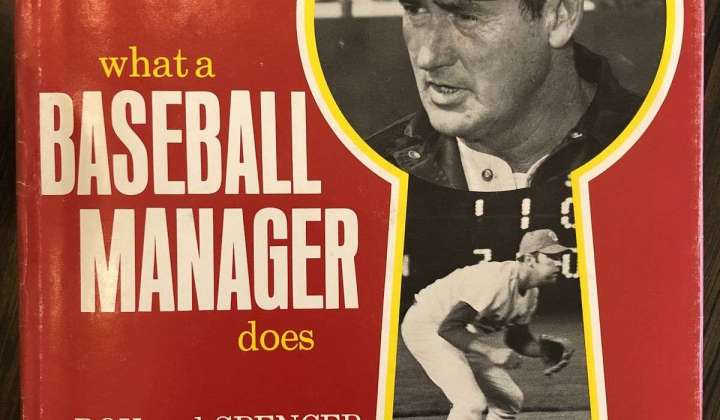LOVERRO: Ted Williams, the Senators and a father-son summer to remember

What were you doing during the summer when you were 14 years old? I was riding my bike to the park every day, swimming and playing basketball.
Here’s what I wasn’t doing — going to Major League Baseball games, taking pictures of Frank Howard and helping my father write a book about Ted Williams and his first season managing the Washington Senators.
That is how Spencer Hoopes spent his summer of 1969, when his father, veteran Washington journalist Roy Hoopes, was gathering material for his book, “What a Baseball Manager Does,” one of a series published by the John Day Company about interesting jobs and the people who did them.
“My friends were totally jealous,” said Spencer, now 67, a musician with the local group the Soul Crackers. “We brought some of them to the game with us sometimes.”
Most days, though, it was all business for Spencer, who, according to the book jacket, “helped his father on the book by organizing the newspaper sports section file, taking pictures, developing prints in the darkroom and lugging several pounds of camera equipment to the many games they attended.”
“I have not had any early writing experience,” a young Spencer said. “I enjoy baseball and football very much. And I have no steady job at the moment.”
His father, who passed away in 2009, was an accomplished Washington writer. He had been the managing editor of High Fidelity magazine and the Washingtonian. He also worked for Time-Life International and National Geographic. He wrote numerous books, including The Peace Corps Experience and Getting With Politics.
The baseball manager book was the third in a series that included similar explainers on the president of the United States and a United States senator.
Of all the years to pick for a book on the Senators.
The Hoopes duo struck gold in 1969: It was the Senators’ first year with Hall of Fame manager Ted Williams, who would lead the team to an 86-76 record — their best season in their second incarnation.
The book included photos and stories from spring training in West Palm Beach to the end of the season, when Williams was named Associated Press American League Manager of the Year.
Here’s an excerpt from Williams’ decision to cut pitcher Phil Ortega before the end of spring training. “Williams continuously kept after him in the spring to work on his curve, but Ortega did not make much effort to throw more breaking stuff,” Roy wrote. “In addition, he violated Williams’ camp rules a couple of times by staying out after the curfew. Finally, as spring training was nearing to a close and Ortega had been knocked out of the box in several exhibition games, Williams made his decision: Washington asked waivers on Ortega, meaning they agreed to let him go for the waiver price of $20,000 to any club who wanted him. ‘He didn’t show me anything, and more important, he didn’t have the desire to show me anything,’ Williams said. ‘We tried to trade him, but no one wanted him.’”
This was heady stuff for a 14-year-old Montgomery County baseball fan. “I always felt lucky to be included in helping write the book, even though I was young and didn’t do any ‘writing’ per se,” Spencer said. “He did ask my opinion occasionally but he did the writing.
“We would sit in first row behind the third base dugout at RFK Stadium so we could put the tripods on the roof of the dugout and get good shots of Williams and the players,” Spencer said. “Things were a lot more relaxed in those days.”
They were there on a day when Williams — one of the greatest hitters in baseball history who retired in 1960 — took batting practice.
“Williams decides to hit a few and, as usual, whenever Williams steps into the cage, the Washington players pay attention,” Roy wrote. “After hitting four or five pitches, Williams, laughing, yells to coach Nellie Fox, who is pitching batting practice: ‘If I don’t hit the next one out, I’ll quit the game forever.’
“This brings loud cries from the players for Fox to ‘strike him out.’ Williams hits the pitch to the base of the 355-foot sign on the right field fence, then steps out of the batting cage, saying, ‘Goodbye, sports fans. That’s it.’”
They described the scene of the final day of the season, when Williams, a spokesman for Sears sporting goods, gave each player a fishing rod. “On the last night of the season, Williams puts a fishing rod in each player’s locker as an appreciation for their hustle and hard work,” Roy wrote. “After the clubhouse ceremonies, the Williams station wagon pulls out of the stadium garage.”
Spencer said he didn’t have much interaction with Williams himself. “But Frank Howard and some of the others, like Ed Brinkman, Tim Cullen and Paul Casanova, they were very friendly,” Spencer said. “Egos and attitudes were in check back then.”
⦁ You can hear Thom Loverro on The Kevin Sheehan Show podcast.






